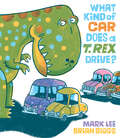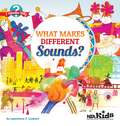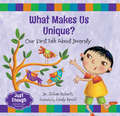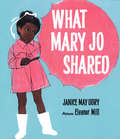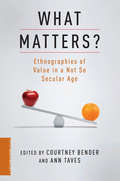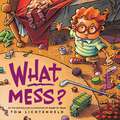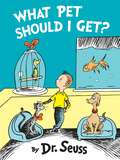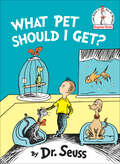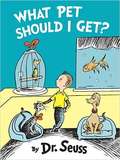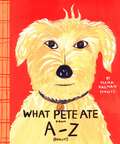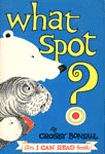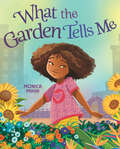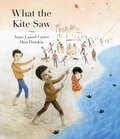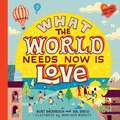- Table View
- List View
What Kind of Car Does a T. Rex Drive?
by Mark LeeDinosaurs find their ideal vehicles in this hilarious, crowd-pleasing read-aloud, perfect for fans of Dragons Love Tacos and Goodnight, Goodnight, Construction Site. It's the perfect gift for dinosaur lovers and fans of cars, trucks, and all things that go!When a stegosaurus, a pterodactyl, and a triceratops all show up at Uncle Otto's car lot, he doesn't have a clue how to help them. After all, he's never sold a car to a dinosaur before. Luckily, Ava and Mickey--two kids with a lot of dino knowledge--are there to help pair each customer with the perfect vehicle. But here comes the T. Rex, and he wants to buy a car too! And he's surprisingly hard to please... So what kind of car does a T. Rex drive? A microcar? A convertible? A minivan? You'll just have to read to find out!"A delightful blend of dinosaurs with things that go, sure to entertain aficionados of both." --Booklist"Only the extinct would fail to enjoy this kicky amalgamation of dinos, deals, and automobiles." --Kirkus Reviews"Smashed cars, expert kids, dinosaurs! Customer satisfaction guaranteed!" --The Horn Book Magazine
What Lives in a Shell? (Let's-Read-and-Find-Out Science 1)
by Kathleen Weidner ZoehfeldRead and find out about what lives in a shell in this colorfully illustrated nonfiction picture book.A house is a home for you, a nest is a home for a bird, and a cave is a home for a bear. But for some animals a shell is a home. Snails and turtles and crabs and clams all have shells that act as their homes and protect them from harm.This clear and appealing book for early elementary age kids, both at home and in the classroom, is a fascinating exploration of the many creatures that make a home in a shell. This picture book features beautifully accurate illustrations of the many types of shells—inside and out! Young readers will love exploring the fascinating homes of creatures like hermit crabs, scallops, and turtles.This is a Level 1 Let's-Read-and-Find-Out, which means the book explores introductory concepts perfect for children in the primary grades. The 100+ titles in this leading nonfiction series are:hands-on and visualacclaimed and trustedgreat for classroomsTop 10 reasons to love LRFOs:Entertain and educate at the same timeHave appealing, child-centered topicsDevelopmentally appropriate for emerging readersFocused; answering questions instead of using survey approachEmploy engaging picture book quality illustrationsUse simple charts and graphics to improve visual literacy skillsFeature hands-on activities to engage young scientistsMeet national science education standardsWritten/illustrated by award-winning authors/illustrators & vetted by an expert in the fieldOver 130 titles in print, meeting a wide range of kids' scientific interestsBooks in this series support the Common Core Learning Standards, Next Generation Science Standards, and the Science, Technology, Engineering, and Math (STEM) standards. Let's-Read-and-Find-Out is the winner of the American Association for the Advancement of Science/Subaru Science Books & Films Prize for Outstanding Science Series.
What Magnets Can Do
by Allan FowlerDesigned to provide children with "hands-on" experience in magnetism and magnets.
What Makes a Blizzard? (Let's-Read-and-Find-Out Science 2)
by Kathleen Weidner ZoehfeldRead and find out about blizzards in this colorfully illustrated nonfiction picture book.All blizzards are snowstorms, but not all snowstorms are blizzards. What is the difference? How much snow falls during a blizzard? How fast are the winds? How cold does it get during a blizzard? Read and find out! What Makes a Blizzard comes chock-full of visual aids like charts, sidebars, and hands-on activities—including how to keep a winter weather journal and how to observe what a snowflake really looks like.This is a clear and appealing science book for early elementary age kids, both at home and in the classroom. It's a Level 2 Let's-Read-and-Find-Out, which means the book explores more challenging concepts for children in the primary grades. The 100+ titles in this leading nonfiction series are:hands-on and visualacclaimed and trustedgreat for classroomsTop 10 reasons to love LRFOs:Entertain and educate at the same timeHave appealing, child-centered topicsDevelopmentally appropriate for emerging readersFocused; answering questions instead of using survey approachEmploy engaging picture book quality illustrationsUse simple charts and graphics to improve visual literacy skillsFeature hands-on activities to engage young scientistsMeet national science education standardsWritten/illustrated by award-winning authors/illustrators & vetted by an expert in the fieldOver 130 titles in print, meeting a wide range of kids' scientific interestsBooks in this series support the Common Core Learning Standards, Next Generation Science Standards, and the Science, Technology, Engineering, and Math (STEM) standards. Let's-Read-and-Find-Out is the winner of the American Association for the Advancement of Science/Subaru Science Books & Films Prize for Outstanding Science Series.
What Makes a Magnet? (Let's-Read-and-Find-Out Science 2 #Stage 2)
by Dr. Franklyn M. BranleyRead and find out about magnets in this colorfully illustrated nonfiction picture book.Why does a magnet pick up a paper clip but not a leaf or a penny? How can the whole world be a magnet?Follow the step-by-step instructions about how to make your own magnet, and then find out for yourself what makes a magnet!This is a clear and appealing science book for early elementary age kids, both at home and in the classroom. It's a Level 2 Let's-Read-and-Find-Out, which means the book explores more challenging concepts for children in the primary grades. The 100+ titles in this leading nonfiction series are:hands-on and visualacclaimed and trustedgreat for classroomsTop 10 reasons to love LRFOs:Entertain and educate at the same timeHave appealing, child-centered topicsDevelopmentally appropriate for emerging readersFocused; answering questions instead of using survey approachEmploy engaging picture book quality illustrationsUse simple charts and graphics to improve visual literacy skillsFeature hands-on activities to engage young scientistsMeet national science education standardsWritten/illustrated by award-winning authors/illustrators & vetted by an expert in the fieldOver 130 titles in print, meeting a wide range of kids' scientific interestsBooks in this series support the Common Core Learning Standards, Next Generation Science Standards, and the Science, Technology, Engineering, and Math (STEM) standards. Let's-Read-and-Find-Out is the winner of the American Association for the Advancement of Science/Subaru Science Books & Films Prize for Outstanding Science Series.
What Makes a Magnet?
by Franklyn M. BranleyDescribes how magnets work and includes instructions for making a magnet and a compass. A book in the Let's-Read-and-Find-Out Science book series.
What Makes Day and Night
by Franklyn M. Branley"What Makes Day and Night" goes through the cycle of the earth and its revolutions around the sun.
What Makes Different Sounds (I Wonder Why Ser.)
by Lawrence LoweryOn their walk home from school, twins Jane and Jim explore why sounds can be startling (like sirens), soothing (like music), or mysterious (like eerie creaking in an empty house). By coming along, young readers of What Makes Different Sounds? can learn as the twins do. They’ll be introduced to the roles vibration, pitch, and volume play in how rustles, rumbles, and rat-a-tat-tats are made and transferred to their own ears. What Makes Different Sounds? is part of the I Wonder Why book series, written to ignite the curiosity of children in grades K–6 while encouraging them to become avid readers. These books explore the marvels of sound, animals, plants, and other phenomena related to science and nature. Included in each edition is a Parent/Teacher Handbook with coordinating activities. The I Wonder Why series is written by an award-winning science educator and published by NSTA Kids, a division of NSTA Press.
What Makes Me Special: A neurodiverse child's journey
by Claudia Rose AddeoThis children’s piece of literature can be read by children ages 4-9, but also welcomes readers of all ages who are among the neurodiverse community. This bright, colorful children’s book reflects the author’s childhood navigating a mainstream education system through the eyes of a neurodiverse learner. A very happy-go-lucky child shares all of the obstacles and gifts that come with being a neurodiverse learner and how that can appear in her everyday life. Whether it entails navigating sensory overload, demonstrating her creative talents, or receiving special education services, Claudia shares all of the unique aspects of her childhood that also relate to so many other children among the neurodiverse community. Though there are certainly times that Claudia can face challenges that appear overwhelming, this sensitive, kind, and optimistic little girl always manages to remind herself that hard work does pay off and understands that these are the qualities that make her special. Claudia reminds readers of all ages the importance of being kind and accepting of one another, as well as being able to recognize the many beautiful gifts neurodiverse learners possess that make them special!
What Makes Us Unique?: Our First Talk About Diversity (Just Enough)
by Dr Jillian Roberts Cindy RevellWhen it comes to explaining physical, cultural and religious differences to children, it can be difficult to know where to begin. What Makes Us Unique? provides an accessible introduction to the concept of diversity, teaching children how to respect and celebrate people's differences and that ultimately, we are all much more alike than we are different. Additional questions at the back of the book allow for further discussion. Child psychologist Dr. Jillian Roberts designed the Just Enough series to empower parents/caregivers to start conversations with young ones about difficult or challenging subject matter. Other books in the series deal with birth, death, separation and divorce. For more information, visit www.justenoughseries.com.
What Mary Jo Shared
by Janice May Udry Elizabeth SaylesMary Jo is a very shy little girl. When it comes time to share something in class she has nothing to share. She comes up with several ideas of what to share, but at the last minute says she has nothing to share. In the end she is able to find the perfect thing to share. It is something that no one else in the class has thought of sharing before.
What Matters?: Ethnographies of Value in a Not So Secular Age (A Columbia / SSRC Book)
by Courtney Bender Ann TavesOver the past decade, religious, secular, and spiritual distinctions have broken down, forcing scholars to rethink secularity and its relationship to society. Since classifying a person, activity, or experience as religious or otherwise is an important act of valuation, one that defines the characteristics of a group and its relation to others, scholars are struggling to recast these concepts in our increasingly ambiguous, pluralistic world.This collection considers religious and secular categories and what they mean to those who seek valuable, ethical lives. As they investigate how individuals and groups determine significance, set goals, and attribute meaning, contributors illustrate the ways in which religious, secular, and spiritual designations serve as markers of value. Reflecting on recent ethnographic and historical research, chapters explore contemporary psychical research and liberal American homeschooling; the work of nineteenth and early-twentieth-century American psychologists and French archaeologists; the role of contemporary humanitarian and volunteer organizations based in Europe and India; and the prevalence of highly mediated and spiritualized publics, from international psy-trance festivals to Ghanaian national political contexts. Contributors particularly focus on the role of ambivalence, attachment, and disaffection in the formation of religious, secular, and spiritual identities, resetting research on secular society and contemporary religious life while illuminating what matters in the lives of ordinary individuals.
What Mess?
by Tom LichtenheldPreviously published in hardcover with the title "What's With This Room?" Why is this room such a mess all the time? What's with that smell, and what's with the grime? What Mess?is a hilarious conversation between a boy and his parents about a room that's such a disaster zone, he'd have to clean it just to call it a mess.
What The Moon Is Like
by Franklyn M. Branley True KelleyImagine that you're walking on the moon. What is it like? For thousands of years people looked up at the moon and wondered about it. Now we know what the moon is like. There is no air on the moon and nothing grows, but there are towering mountains and deep craters--and much more! Colder than the desert, the hotter than the desert, the moon is an amazing place to explore.
What Pet Should I Get? (Classic Seuss)
by Dr. SeussA #1 New York Times bestseller! This previously never-before-seen picture book by Dr. Seuss about making up one&’s mind is the literary equivalent of buried treasure! What happens when a brother and sister visit a pet store to pick a pet? Naturally, they can&’t choose just one! The tale captures a classic childhood moment—choosing a pet—and uses it to illuminate a life lesson: that it is hard to make up your mind, but sometimes you just have to do it! Told in Dr. Seuss&’s signature rhyming style, this is a must-have for Seuss fans and book collectors, and a perfect choice for the holidays, birthdays, and happy occasions of all kinds. An Editor&’s Note at the end discusses Dr. Seuss&’s pets, his creative process, and the discovery of the manuscript and illustrations for What Pet Should I Get?
What Pet Should I Get? (Beginner Books)
by Dr. SeussPick a pet with Dr. Seuss with this bestselling and silly tail of cats, dogs and more! A dog or a cat? A fish or a bird? Or maybe a crazy creature straight from the mind of Dr. Seuss! Which pet would YOU get? A trip to the pet store turns into a hilarious struggle when two kids must choose one pet to take home... but everytime they think they see an animal they like, they find something even better! Perfect for animal lovers and Seuss lover alike, this book will delight readers young and old. Discovered 22 years after Dr. Seuss's death, the unpublished manuscript and sketches for What Pet Should I Get? were previously published as a 48-page jacketed hardcover with 8 pages of commentary. This unjacketed Beginner Book edition features the story only. The cat? Or the dog? The kitten? The pup? Oh, boy! It is something to make a mind up. Beginner Books are fun, funny, and easy to read! Launched by Dr. Seuss in 1957 with the publication of The Cat in the Hat, this beloved early reader series motivates children to read on their own by using simple words with illustrations that give clues to their meaning. Featuring a combination of kid appeal, supportive vocabulary, and bright, cheerful art, Beginner Books will encourage a love of reading in children ages 3–7.
What Pet Should I Get?
by Dr SeussThis never-ever-before-seen picture book by Dr. Seuss about making up one's mind is the literary equivalent of buried treasure! What happens when a brother and sister visit a pet store to pick a pet? Naturally, they can't choose just one! <P><P> The tale captures a classic childhood moment--choosing a pet--and uses it to illuminate a life lesson: that it is hard to make up your mind, but sometimes you just have to do it! <P> Told in Dr. Seuss's signature rhyming style, this is a must-have for Seuss fans and book collectors, and a perfect choice for the holidays, birthdays, and happy occasions of all kinds. <P> An Editor's Note at the end discusses Dr. Seuss's pets, his creative process, and the discovery of the manuscript and illustrations for What Pet Should I Get?
What Pete Ate from A to Z
by Maira KalmanIs there anything Pete won't eat? Poppy Wise's sweet but unruly dog starts with Nico's accordion and works his way through the alphabet, making a nuisance of himself by leaving nothing untouched, not even glue sticks or Uncle Norman's underpants. Despite Pete's ravenous ways, a frazzled Poppy Wise can't help loving him. Kids will laugh at Pete's impossible cuisine, adults will appreciate the offbeat sense of humor, and both will love the artwork that perfectly captures the fun of the text in this unique alphabet book only Maira Kalman could create.
What Should I Wear? (Rigby Lighthouse #Levels B-D)
by Penny LeeIn this book, a girl tells us what she wears in different weather.
What Spot? (I Can Read #Level 1)
by Crosby BonsallWhen is a spot not a spot? It depends whom you listen to -the walrus or the puffin. This hilarious tale by the author of such popular I CAN READ Books as who's a pest? and tell me some more answers this perfectly logical question with wit, charm, and high good humor. It was the walrus who first saw the spot-a black spot in the white, white snow. He would have investigated it at once had not the puffin-a know-it-all bird of diminutive stature-insisted that it was nothing, nothing at all. And the walrus had great respect for the puffin's intellect-up to a point. In uproarious words and pictures, Mrs. Bonsall describes just what happens when nothing turns out to be a very definite something. Beginning readers, when they stop laughing long enough to read the words, will find this book utterly and completely satisfying. Picture descriptions are included when they help explain what's going on in the story.
What the Garden Tells Me
by Monica MikaiThere&’s nothing like stepping into a garden and connecting with nature, and readers will revel in the pages of this beautiful picture book that celebrates these wondrous and inspiring places!Gardens are glorious places blossoming with joy, wonder, and wisdom too. Whether it&’s greeting the possibilities of each sunrise with the daylilies or appreciating what makes us as unique as the polkadot plant; whether it&’s contemplating life&’s thorns with the roses or standing as tall as a sunflower, spending time in nature can give us new ways of seeing. This flora-filled ode will inspire readers to observe the plants around them and appreciate the things that make each one—and each of us—special.
What the Kite Saw
by Anne Laurel CarterIn this memorable story, a young boy finds solace flying his kite from the rooftop after soldiers take his father and brother away. Without his father and brother, the young boy’s life is turned upside down. He and his family have to stay inside, along with everyone else in town. At suppertime, he can’t stop looking at the two empty places at the table and his sister can’t stop crying. The boy looks out the window and is chilled to see a tank’s spotlight searching the park where he plays with his friends. He hears shouts and gunshots and catches sight of someone running in the street — if only they could fly away, he thinks. Each day the curfew is lifted briefly, and the boy goes to the park to see his friends. One day, inspired by the wind in the trees, he has an idea. Back at home he makes a kite, and that night he flies it from his rooftop, imagining what it can see. In this moving story from Anne Laurel Carter, with haunting illustrations by Akin Duzakin, a young boy finds strength through his creativity and imagination. Correlates to the Common Core State Standards in English Language Arts: CCSS.ELA-LITERACY.RL.2.3 Describe how characters in a story respond to major events and challenges.
What the World Needs Now Is Love
by Burt Bacharach Hal DavidFor anyone who needs to be reminded of the power of love, this beautiful book is the perfect gift!With its soothing lyrics and calming tones, "What the World Needs Now Is Love" has become a beloved song worldwide since its release in 1965. Now, for the first time ever, these captivating lyrics are in book form accompanied by gorgeous illustrations, and perfectly packaged with a ribbon enclosure.Both a reminder of the importance of love and a call to make the world a better place, this book is the perfect gift for anyone you care about—or for yourself when you need some gentle comfort.
